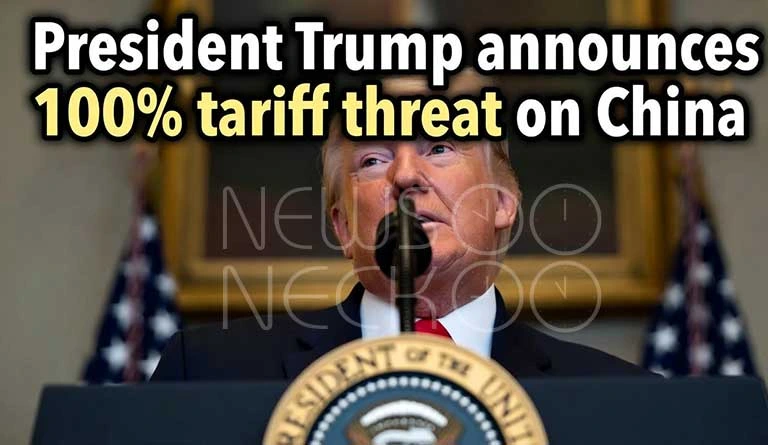American Farmers, Federal Workers Caught in Crossfire of Escalating Trade War
As Trump threatens 100% tariffs on China and a government shutdown triggers federal layoffs, rural communities face a devastating convergence of political battles.
WASHINGTON — The soybeans sit in silver grain bins, enough to fill 100,000 bushels, waiting for a market that has vanished. In southern Minnesota, Matt Purfeerst walks past these silent stores every day, facing a problem no amount of hard work can solve.
“We are gonna have to find a home for them soybeans some time soon,” said Purfeerst, a fifth-generation farmer. “They won’t stay in our bins for ever”.
No other country bought as many American soybeans as China, more than $12 billion worth last year alone. This year, that market has disappeared completely, with China refusing to purchase a single dollar’s worth of American soybeans. This abrupt halt comes as former President Donald Trump threatens to impose 100% tariffs on China, escalating a trade war that has left American farmers stranded and desperate.
The trade conflict has created what farmers call “farmageddon” a perfect storm of vanished markets, rising costs, and storage crises. For many agricultural communities that supported Trump politically, the situation feels like a betrayal.
“It just seems like things have stalled all summer long,” said Brian Warpup, who grows corn and soybeans on his 3,900-acre farm in northeastern Indiana. “We’re always hopeful that those negotiations are moving forward, but yet with harvest here, patience may be running thin”.
A Government in Disarray
The trade war escalation coincides with another major crisis: a federal government shutdown now in its third week. The Trump administration has begun laying off thousands of federal workers, with more than 4,000 reduction-in-force notices issued Friday alone.
“The RIFs have begun,” White House Office of Management Director Russell Vought announced on social media, using the government acronym for “reductions in force”.
The layoffs span multiple agencies, with the Treasury Department and Health and Human Services each seeing over 1,000 employees receive notices. The situation has sparked legal challenges from unions representing federal workers.
“It is disgraceful that the Trump administration has used the government shutdown as an excuse to illegally fire thousands of workers who provide critical services to communities across the country,” said Everett Kelley, national president of the American Federation of Government Employees.
Trump acknowledged the layoffs Friday, telling reporters the number of affected workers will “be a lot” and suggesting they would be “Democrat-oriented”.
You might like reading: Japan & US $550 billion trade deal shocks world
The Agricultural Toll
For farmers, the trade war has created impossible calculations. The same week Trump threatened 100% tariffs on China, farmers across the Midwest were harvesting what many call a “bumper crop”—an abundant yield that now sits with nowhere to go.
The storage concerns are “like a tidal wave of problems coming towards Illinois,” said Ryan Frieders, a soybean and corn farmer.
The situation has become so dire that some fear it could lead to tragic consequences in rural communities where suicide rates among farmers already exceed national averages.
“They’re going to see farmers that choose to take their own lives,” said Caleb Ragland, a Kentucky soybean farmer and president of the American Soybean Association, who has voted for Trump in every presidential election since 2016.
The following table shows the dramatic impact on U.S. soybean trade with China:
| Metric | Pre-Trade War | Current Situation | Change |
|---|---|---|---|
| Soybean exports to China | Over $12 billion annually | $0 this year | 100% decrease |
| Farmer sentiment | Four-year high in May 2025 | Three-month decline to pessimistic outlook | Rapid deterioration |
| Farm bankruptcies | Already up 55% last year | Rising again in 2025 | Worsening trend |
Political Crosscurrents
The convergence of the trade war and government shutdown has created strange political alignments. Republican Senator Susan Collins of Maine broke with the Trump administration over the federal worker layoffs.
“I strongly oppose OMB Director Russ Vought’s attempt to permanently lay off federal workers who have been furloughed due to a completely unnecessary government shutdown,” Collins said .
Meanwhile, Republican lawmakers from agricultural states find themselves in an awkward position—largely supportive of Trump’s trade policy but facing constituents in desperate need of relief.
“Representing an Ag state, this has very direct consequences,” Senate Majority Leader John Thune told Punchbowl News. “We’re going to have some real issues in farm country with regard to trade and markets more generally”.
The White House has blamed Democrats for both the shutdown and the delay in helping farmers.
“Unfortunately, Democrats in Congress have stalled progress on this issue with their prolonged shutdown to serve illegal immigrants instead of America’s farmers,” spokeswoman Anna Kelly said.
The Human Calculation
Back in Minnesota, Matt Purfeerst considers his options. Because of his farm’s location, he can sell domestically to soybean crush facilities, sell on the rail market, or put product on barges down the Mississippi River. Other soybean farmers in more remote parts of the Midwest aren’t as lucky.
The volatility creates impossible risk management decisions.
“Let’s say tomorrow we get a trade deal with China, and it’s favorable to soybeans. All of a sudden you might see this market jump from $10 to $12 in three, four days,” Purfeerst said. “So it makes it extremely challenging from a risk management standpoint of: when do you market your crop, and how many eggs do you put in that basket? The potential is $12, but if we don’t get a trade deal, it could go to $9”.
For many farmers, the situation echoes Trump’s first-term trade war, which led to billions in bailout payments to farmers money that some criticized as “hush money to keep them sedated”.
An Uncertain Future
As the shutdown continues and tariff threats loom, the mood in farm country grows increasingly grim. The American Soybean Association wrote to Trump in August, warning that the nation’s soybean farmers were “standing at a trade and financial precipice” and “cannot survive a prolonged trade dispute with our largest customer”.
Eric Euken, a seventh-generation farmer in western Iowa, captured the uncertainty gripping agricultural communities.
“We don’t know what’s happening next from day to day,” said Euken, who noted that his operation is surviving only because pigs and cattle are making up for losses on corn and soybeans.
Like many farmers, Euken faces a difficult reality: the markets that took generations to build have disappeared in months, and the political battles playing out in Washington offer little comfort to those struggling to survive the next harvest.
As Purfeerst noted, only 1% of the population works in agriculture anymore, leaving farmers feeling misunderstood and increasingly caught in political crossfires.
With the government shutdown continuing and 100% tariffs on the table, that crossfire is intensifying, leaving farmers and federal workers alike wondering when, or if, the political battles will end and their livelihoods will be secured.
This story was reported from Washington, D.C., with contributions from correspondents in Minnesota, Indiana, Iowa, and Kentucky.
Author: Junaid Arif
Date: 11 Oct, 2025
For More Updates, Visit Newsneck













